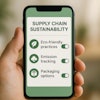
The expectation for companies to have a concrete strategy in place for supply chain sustainability continues to rise, leading many to look beyond goals for their own operations and consider their suppliers’ operations.
The concept of supplier sustainability can have different meanings for different organizations. For some, sustainability means supplier compliance with multiple ESG issues in accordance with local and global regulations. For others, sustainability might extend to issues beyond compliance, such as greenhouse gas (GHG) emissions reduction, workforce diversity or deforestation.
In recent years, companies have been taking varying steps to evaluate their supplier sustainability initiatives. For example, Walmart with its Project Gigaton initiative has aimed to encourage suppliers to reduce upstream and downstream (beyond-the-shelf) GHG emissions and Apple recently announced plans to evaluate the impact of its major manufacturing partners to decarbonize their Apple-related operations, with the intent to have suppliers in its global supply chain decarbonize by 2030.
While some organizations are already taking steps to understand their suppliers’ sustainability practices and, in some cases, are playing an active role in collaborating with their supplier networks to achieve goals, other organizations are at an earlier stage or have yet to take action.
With the current state of disruption and economic uncertainty, it can be tempting to postpone sustainability efforts. However, Gartner research points to continued investment in sustainability programs over the next two years as a strategy to mitigate disruptive impacts, with 86% of business leaders viewing sustainability as an investment which protects their organization from disruption. To ensure supply chain resilience, chief supply chain officers (CSCOs) should balance short and long-term priorities, understanding that sustainability is no longer a nice-to-have, but critical to reduce risk.
For CSCOs wondering where to begin with understanding supplier sustainability practices and for those that are looking to continue building the business case within their organization, consider the following:
The Business Case for Gaining Visibility
Supply chains can be a significant source of untapped value for organizations. They can maximize efficiencies and identify new opportunities for product innovation and service delivery that support ESG goals in line with a low carbon future. Alternatively, the supply chain can expose organizations to financial, regulatory or operational risks if ESG factors are not considered during strategy development and execution. In a Gartner survey, 72% of supply chain leaders acknowledge that climate change impacts, most commonly in the form of environmental events, may affect their ability to deliver an effective supply chain strategy.
For many organizations, Scope 3 emissions in the upstream supply chain, or emissions related to suppliers and outside of their direct control, are much higher than emissions from direct operations (Scope 1 and 2). Suppliers contribute significantly to an organization’s carbon footprint, and achievement of greenhouse gas (GHG) emission targets, including Net Zero goals, hinge on effective supplier engagement.
Having visibility into supplier sustainability practices is critical to meeting decarbonization goals, improving the environmental impact of products and services, and building more resilient supply chain networks.
Engaging with and Incentivizing Suppliers Drives Impact
Suppliers may lack the resources and capabilities to drive emissions reductions on their own, requiring collaboration and partnership to enable progress. Moreover, supplier engagement is not a one size fits all. Organizations can offer solutions addressing various challenges, meeting suppliers where they are on their sustainability journey. Engagement can range from guidance on baselining GHG emissions, setting targets, identifying opportunities for emissions abatement, sources of financing and peer networking opportunities.
Supply chain leaders should define incentives to accelerate progress among key suppliers. Lead with a balance of financial and non-financial incentives, such as reward and recognition programs, co-branding opportunities or favorable payment terms. Incentives should be focused on supplier progress of sustainability goals, and not on an initial assessment of maturity. In the case of a lack of ambition or progress, supply chain leaders should assess the tradeoffs of switching suppliers to minimize risk.
Tracking Progress Helps Move the Needle
Supplier sustainability must be embedded into existing procurement processes across the entire supplier lifecycle. Procurement has been focused on cost, quality, and service for decades, but with increasing stakeholder expectations and expanding global legislation, an isolated approach to measuring sustainability is no longer strategically viable.
Procurement leaders should set expectations early with supplier selection criteria, include sustainability KPIs in scorecards, and hold suppliers accountable for continuous improvement. Leveraging technology to track progress can allow valuable resources to focus on strategic activities such as building supplier awareness and capability.
Whether public or private, large or small, nearly all organizations will benefit from gaining visibility into supplier sustainability initiatives. Stakeholder expectations and regulatory changes will continue to evolve and force organizations to implement and scale their sustainability initiatives. By taking steps now to understand their suppliers’ practices, companies will be able to scale their initiatives and impact.



















